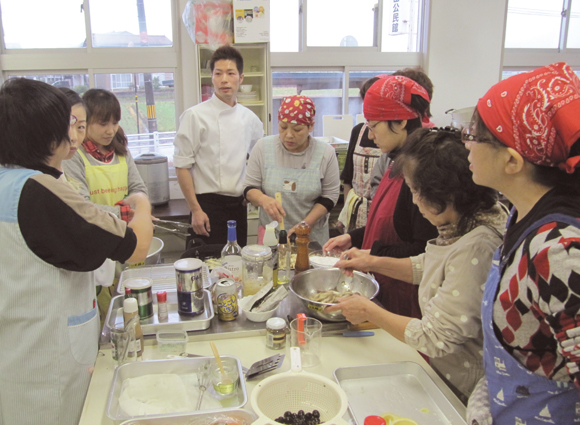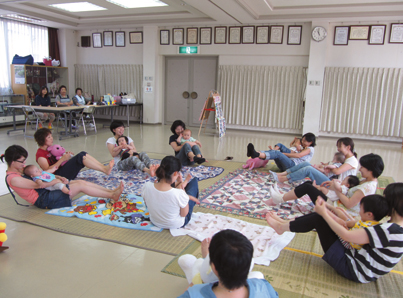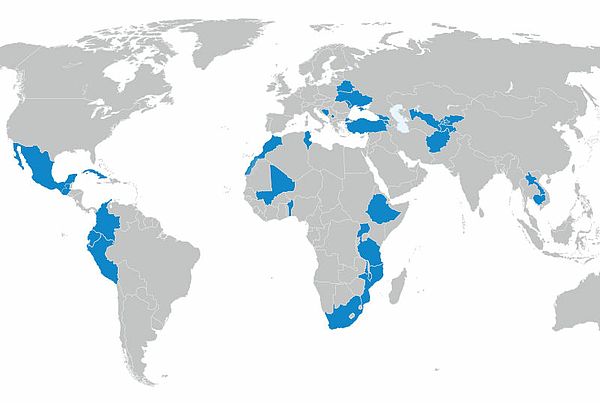
Cooking together.
The end of World War II in 1945 generated extreme poverty in Japan. The central government established Kominkan, which turned out to be a good match for people's needs to learn new values and to improve their lives. During this period, popular activities at the Kominkan included women’s empowerment, a better quality of a healthy life, income generation, and recreation activities. The Social Education Law, based on the Fundamental Law of Education in 1947, came into effect in 1949, when more than 10,000 Kominkan had been established. The concept of Kominkan is today to promote mutual learning and teaching and to support voluntary learning among local residents.
Kominkan is similar to a Community Learning Centre (CLC) in offering community-based non-formal education. The majority are established and managed by municipalities such as cities, towns, or villages. Most of the approximately 16,000 Kominkan provide space for activities and programmes for life skills, hobbies, and culture. A total of 244 million par ticipants came to 473,000 courses held by Kominkan in 2005. Kominkan is generally located in an elementary school.

Child and mother activity.
The other type of Kominkan are volunteer-based community learning centres, funded by local residents. These are called “autonomous Kominkan” and offer courses similar to the regular Kominkan. It is estimated that Japan has some 70,000 autonomous Kominkan, but no official figures at national level are available. The local residents can request and develop programmes they want to learn for their own purposes at the autonomous Kominkan.
Enzan Kominkan, located in nor thern Japan, is a small but active Kominkan. The latest activities are displayed on their Facebook page. Ms Yukie Matsui, a Social Education Officer, introduced “Manmaruchi” as a family support project in the Enzan district.
The Japanese economic boom in the late 1960s quickly changed the idyllic Enzan area. The original residents mixed with the newcomers of nuclear families or business commuters. The area saw a development of a growing disparity between the dif ferent resident groups. The newcomers felt alone because they had few friends to talk to about childcare and education issues.
The Kominkan decided to create a space for parents and children to make friends, to exchange information, and to spend time together. The activity became known as Manmaruchi. The word manmaru refers to “round and soft” in Japanese, and maruchi stands for “multiple and wider views of mothers”. Usually 10 or more mothers with children in kindergarten or elementary school participate in activities such as nail arts, confectionery making, household accounting and housekeeping, and preparation for elementar y school.
One of the challenges facing the Kominkan is that participants come to enroll in existing classes but do not take the initiative to bring others or to suggest or develop other courses. The participants tend to see Kominkan as a provider and themselves as participants, or users of the service.
Another challenge lies in its of ficial nature. Municipal funds pay for management and programme development. This means the Kominkan is accountable to the municipality, but methods are seldom shared among policymakers and researchers. Another serious problem is a decreasing budget for social education, which includes Kominkan, libraries, museums, and community centres. These cuts are in contradiction to the declared policy of the Japanese government toward Lifelong Learning.
More information
Enzan Kominkan (n.d.): Flapping Enzan: Each of us is the central character [Habataku Enzan: Hitori Hitori ga Shujinkou] https://www.facebook.com/enzan.kouminkan
Maruyama, H. (2011): “Social Education” System in Japan. Education in Japan. NIER.
http://bit.ly/1mFAvQA
MEX T & ACCU (2008). Kominkan Community Learning Centers (CLC) of Japan.
http://bit.ly/ VSpTEk
National Kominkan Association http://Kominkan.or.jp
Author
Hideki Maruyama, Ph.D., National Institute for Educational Policy Research (NIER), hidekim@nier.go.jp

DVV International operates worldwide with more than 200 partners in over 30 countries.
To interactive world map